| iMovie's stock QuickTime format settings are good for most situations, but you can also use other compression formats and options by way of QuickTime's Expert Settings. To change image settings: 1. | To export only a few clips, select them in the Timeline or Clips pane.
| 2. | Choose QuickTime from the Share menu, or press Command-Shift-E.
| 3. | In the Share dialog, click the QuickTime icon if it's not already selected.
| 4. | Click the box labeled Share selected clips only to export the range you selected in step 1. Otherwise, ignore this step.
| 5. | Choose Expert Settings from the Compress movie for popup menu (Figure 16.6).
Figure 16.6. QuickTime's Expert Settings provide many more options for controlling the compression. 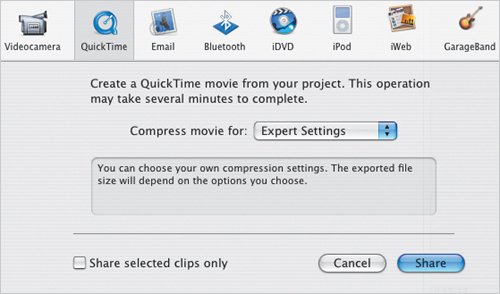
| 6. | Click the Share button.
| 7. | In the Save Exported File As dialog, make sure Movie to QuickTime Movie is selected in the Export popup menu, and click the Options button (Figure 16.7).
Figure 16.7. Click the Options button in the Save dialog to access specific custom settings. 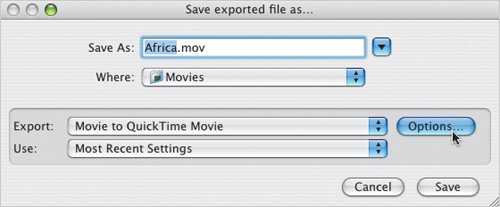
| 8. | The Movie Settings dialog displays the current video and sound settings (Figure 16.8). To fine-tune the type and amount of video compression applied, click the Settings button under Video.
Figure 16.8. The Movie Settings dialog presents an overview of the current export settings. 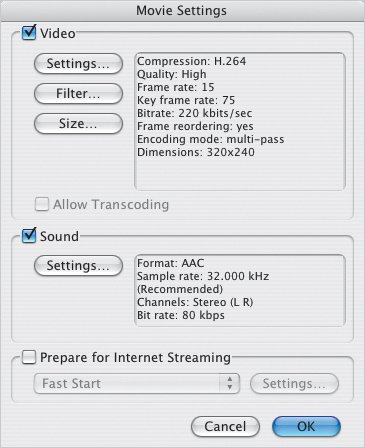
| | | 9. | In the top area of the Compression Settings dialog, choose a compression method from the first popup menu (Figure 16.9). (Note that this dialog may look different depending on the compression type you're using. The option shown here is H.264.)
Figure 16.9. After that long progression of dialogs, you finally reach Compression Settings, where you can adjust the type and amount of compression used for exporting. 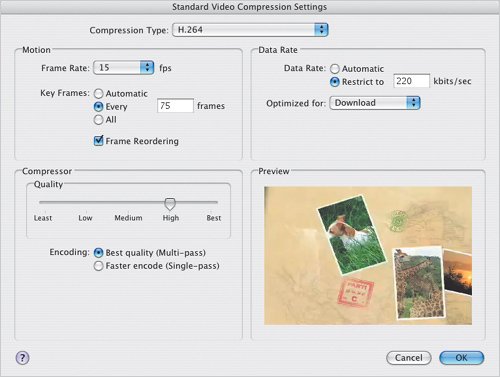
| | | 10. | Move the Quality slider to the lowest level you can that maintains good image quality; the thumbnail shows you how much compression is being applied.
| 11. | In the Motion area, select the number of frames per second from the Frame Rate popup menu.
| 12. | Enter a number in the Key Frames Every [number] frames field to set how often a key frame is generated. Compression works by removing areas of a frame that have not changed since the preceding frame; to create a key frame, iMovie draws an entirely new frame.
| 13. | To target a specific data rate, enter a value in the field labeled Restrict to [number] kbits/sec.
| 14. | Click OK to return to Movie Settings.
| 15. | Click OK to get back to the Save dialog, and then click the Save button to create the file.
|
Tips  | To get a sense for how the compressors compare, create a short movie (30 seconds or so) that's representative of your footage. Then, export it using the various formats and compare the results. The Sorenson Video codecs are highly regarded for having high video quality with good compression. When you select clips in the Clips pane to export, iMovie exports them in the order they were imported, regardless of their positions in the Clips pane. See Table 16.2 on the next page for a summary of the video compressors included with QuickTime. The H.264 codec is mighty impressive, but it's also a resource hog, especially if you opt to use Multi-pass compression. It may take a while to export the file.
|
QuickTime versus QuickTime Pro Every Mac comes with QuickTime, including the free QuickTime Player, which allows you to play back QuickTime movies and a host of other file formats (ranging from MPEG-formatted movies to MP3 audio files). If you're serious about optimizing your QuickTime movies for the Web, however, consider paying the $30 for a QuickTime Pro license, which turns QuickTime Player into a sophisticated movie editor. Not only does it give you an easy way to resize or recompress QuickTime movies, it also lets you save your movies into other formats, such as AVI, which Windows users can view if they don't have QuickTime installed. |
To change audio settings: 1. | Share your movie as described in the previous steps.
| 2. | In the Sound portion of the Movie Settings dialog, click the Settings button to display sound-specific settings (Figure 16.10).
Figure 16.10. Choose an audio compressor to fine-tune how your movie's audio sounds after exporting. 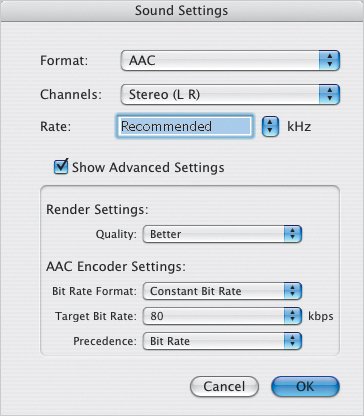
| 3. | Choose a format from the Format popup menu. Some compressors include further settings, which are accessed by clicking the Show Advanced Settings checkbox. These usually determine how the data is encoded, or specify a data rate (or bit rate).
| 4. | Decide whether the audio will play back in stereo or mono by choosing an option from the Channels popup menu. Stereo sounds better, but Mono offers a smaller file size.
| 5. | In the Rate field, type a kHz value or select one from the popup menu to the right. Lower kHz settings will degrade the sound quality.
| 6. | Click OK to exit the sound settings portion of the dialog.
|
Tip  | If you want to export only the audio portion of your movie, choose Sound to AIFF from the Export popup menu in the Save Exported File As dialog. Or, when you're in the Movie Settings dialog, deselect the Video checkbox before exporting.
|
To prepare a movie for Internet streaming: 1. | Share your movie as described in the previous steps.
| 2. | In the Movie Settings dialog, click the Prepare for Internet Streaming box in the lower-left corner (Figure 16.11).
Figure 16.11. To enable Web streaming, click the Prepare for Internet Streaming box and choose a streaming method. 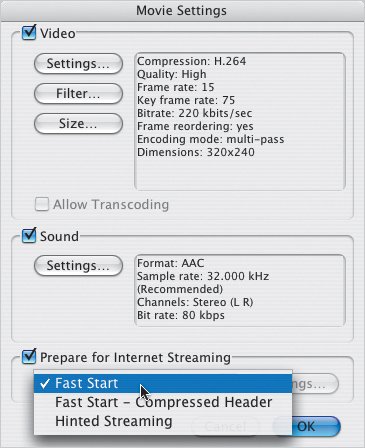
| 3. | From the popup menu, select a streaming method:
- Fast Start. The movie file is downloaded like any other media file, and begins playing once enough data has been transferred.
- Fast Start - Compressed Header. Like Fast Start, the movie is downloaded as one file, but the header information is compressed to save disk space.
- Hinted Streaming. Use this option if the movie will be hosted by a QuickTime Streaming Server. Hinting the data breaks it up into more manageable chunks for streaming. With Hinted Streaming selected, you can click the Settings button to further tweak the settings (Figure 16.12). For more information, see Apple's article: http://docs.info.apple.com/article.html?artnum=301355.
|
Figure 16.12. Preparing a QuickTime movie for streaming can get into a lot of geeky detail, but if you know what you're doing, you can improve streaming quality. 
QuickTime Geekery Trust me: everything described so far in this chapter is really just the tip of a very large iceberg. If you're willing to shell out the bucks, software such as AutoDesk's Cleaner can encode and compress your movies into nearly any possible movie format, with more control than can be found in iMovie's or QuickTime Player's export features. |
|






